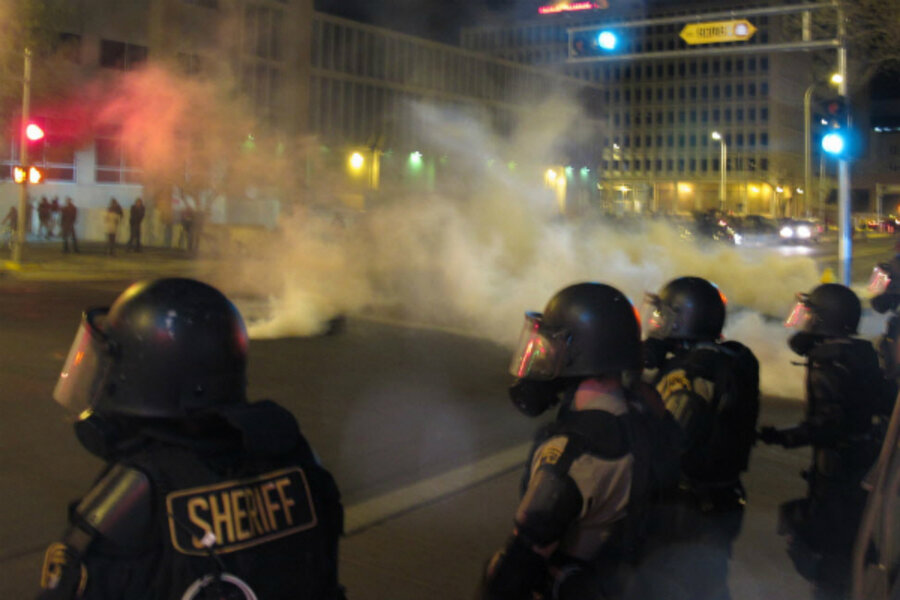Albuquerque protest over police shootings turns to 'mayhem'
Loading...
An Albuquerque protest over a spate of fatal police shootings in the New Mexican city turned from peaceful to violent on Sunday evening, as police officers squared off with demonstrators decrying police brutality.
The website for the Albuquerque Police Department (APD) was also briefly hobbled in a cyberattack on Sunday afternoon, news outlets reported.
The protests and hacking incident followed outrage over APD’s shooting of a homeless man in the Sandia Mountains with what protesters say was dubious cause. The incident – now the subject of an FBI criminal probe – has since put a spotlight on the high number of APD shootings over the past few years, raising questions about whether officers are over-using their right to open fire when threatened.
On Sunday afternoon, hundreds of protesters walked up and down a two-mile stretch between downtown Albuquerque and the University of New Mexico, bearing signs like “APD: Dressed to Kill” and shouting slurs at officers, the Associated Press reported.
Albuquerque Mayor Richard Berry told the Albuquerque Journal that protests had started off nonviolent but devolved into “mayhem” late Sunday night, after the protest had dwindled to about 50 people. Those demonstrators hurled rocks, spat on officers, and defaced a police station, as well as trapped one officer in a car and then tried to break the windows, the mayor told the Journal. One officer was injured responding to the protests, he said.
Police lobbed tear gas canisters into the crowd on Sunday night, breaking up the protest, and some protestors were arrested, according to KRQE, an Albuquerque television station. Photos from the protest show demonstrators with scarves wrapped around their mouths facing off with police in riot gear and gas masks.
A spokesperson for the APD also confirmed to AP that the police website had been hacked from about 11 a.m. until late afternoon on Sunday, but that no vital services had been impacted.
In a YouTube video put up about a week before the protests Sunday, a group claiming to be the global hacking group Anonymous had called for a demonstration and announced plans to hack city government websites. The APD spokesperson told AP that the hacking source had not yet been identified.
Earlier in March, Albuquerque police officers confronted a homeless man living in an illegal encampment in the foothills of the Sandia Mountains to Albuquerque’s east. In a three-hour standoff, the man, James Boyd, who had a documented history of mental illness, claimed to be a government agent and threatened to kill the officers with a small knife.
Police first shot Mr. Boyd with nonlethal weapons, including stun guns and beanbag guns. But, as seen in a video recorded on one officer’s helmet-camera, officers then shot and killed the man with six rounds of live ammunition, after the situation appeared to have been diffused and Boyd had agreed to leave his campsite. The video shows Boyd packing up his gear and taking a step toward officers, just before one officer opens fire, prompting another officer to follow suit.
The APD police chief later told reporters that the shooting was “justified" and within an officer’s right to use lethal force when threatened.
But the shooting comes amid an ongoing US Justice Department investigation, launched last year, into whether APD officers are exceeding police prerogative to open fire, rather than making all efforts to calm the situation without using lethal means.
Since 2010, Albuquerque police officers have been involved in 37 shootings, 23 of them fatal. About a week after the Sandia incident, APD officers shot another homeless man outside a shelter in circumstances that are disputed.
The FBI has since launched a criminal inquiry into the shooting at Sandia, and the two APD officers who fired shots have been put on leave from the department, according to KRQE.
The mayor has said that he supports the FBI inquiry, telling Al-Jazeera America: “We need answers as a community. I want answers as a mayor.”








